No products in the cart.
Union Budget 2020-21: Small change for human capital development
Against the backdrop of gathering clouds of gloom and despair that have blanketed the economy, the best option of the finance minister was to batten down the hatches, cut unproductive expenditure and invest in developing the country’s abundant and high-potential human capital. Unfortunately, this option wasn’t availed – Dilip Thakore
 On February 1, finance minister Nirmala Sitharaman delivered the longest-ever budget speech while presenting the first Union Budget 2020-21 of the BJP/NDA 2.0 government that was re-elected to power at the Centre with a two-thirds majority in the Lok Sabha last summer. It was a spirited and comprehensive address to Parliament and the nation against the backdrop of gathering clouds of gloom and despair which have suddenly blanketed the until recently high performance Indian economy. Towards the end of her marathon 161-minutes address, Sitharaman was obliged to cut her speech short as she suffered a sharp loss of blood sugar (hypoglycemia). The dizziness, shakiness and arrhythmia the finance minister experienced is somewhat symptomatic of the condition of the Indian economy. But rather than sugar candy — a short-term palliative — the finance minister ingested to recover her spirits, the Union Budget required imagination, innovation and courage to break with business-as-usual practices and precepts. Unfortunately, there’s little evidence of these virtues in the Union Budget 2020-21.
On February 1, finance minister Nirmala Sitharaman delivered the longest-ever budget speech while presenting the first Union Budget 2020-21 of the BJP/NDA 2.0 government that was re-elected to power at the Centre with a two-thirds majority in the Lok Sabha last summer. It was a spirited and comprehensive address to Parliament and the nation against the backdrop of gathering clouds of gloom and despair which have suddenly blanketed the until recently high performance Indian economy. Towards the end of her marathon 161-minutes address, Sitharaman was obliged to cut her speech short as she suffered a sharp loss of blood sugar (hypoglycemia). The dizziness, shakiness and arrhythmia the finance minister experienced is somewhat symptomatic of the condition of the Indian economy. But rather than sugar candy — a short-term palliative — the finance minister ingested to recover her spirits, the Union Budget required imagination, innovation and courage to break with business-as-usual practices and precepts. Unfortunately, there’s little evidence of these virtues in the Union Budget 2020-21.
“I am mindful of presenting the Budget in the backdrop of two cross-cutting developments: (a) proliferation of technologies, specially analytics, machine learning, robotics, bioinformatics and artificial intelligence; and (b) the number of people in the productive age group, i.e, 15-65 years in India being at its highest. This combination is special to contemporary India. Across the world, if there is a shrinking of globalisation, equally there is a debate on the efficacy of monetary policy too. The efforts we have made in the past five years and the energy, enthusiasm and the innovation of our youth are the ignition required to push forward. The Indian spirit of entrepreneurship which has weathered several storms over the centuries inspires and motivates us. We recognise the need to support and further energise this spirit,” said Sitharaman, in her analysis of the global economic scenario.
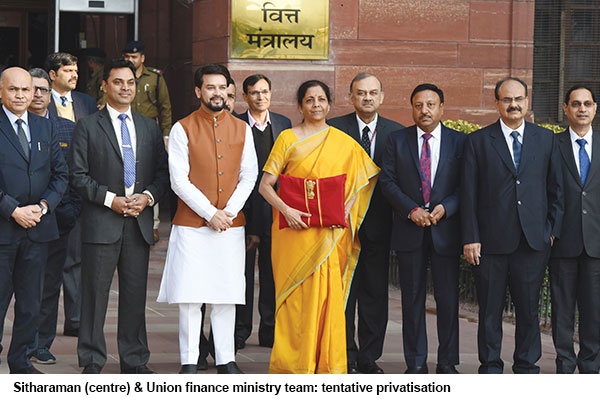
The self-congratulatory reference to the “efforts we have made in the past”, glosses over the pathetic current condition of the Indian economy. Despite the scandals-tainted predecessor Congress-led UPA government’s rule at the Centre (2004-14), the Indian economy clocked an average annual GDP growth rate of 8 percent. But the BJP/NDA government’s big bloomers — demonetisation (2016), injection of populist sentiment in the landmark Goods & Services Tax (GST) introduced in July 2017, neglect of law and order and reluctance to encourage the “Indian spirit of entrepreneurship” during its first term (2014-19) — have driven the high performing Indian economy to the edge.
 “All budget speeches are made in particular economic contexts… The economic context for the present budget included the sharp slowdown of economic growth over the past two years, the worst unemployment/ underemployment situation in nearly 50 years, seven stagnant years of exports, declining investment rates, a stressed financial system and major problems in key sectors. In other words, a near crisis in the economic situation. A striking disappointment about the (budget) speech was that none of this was recognised in the opening pages,” says Dr. Shankar Acharya, an alumnus of Oxford and Harvard universities and former chief economic adviser to the P.V. Narasimha Rao Congress government (1991-96) writing in the Business Standard (February 12).
“All budget speeches are made in particular economic contexts… The economic context for the present budget included the sharp slowdown of economic growth over the past two years, the worst unemployment/ underemployment situation in nearly 50 years, seven stagnant years of exports, declining investment rates, a stressed financial system and major problems in key sectors. In other words, a near crisis in the economic situation. A striking disappointment about the (budget) speech was that none of this was recognised in the opening pages,” says Dr. Shankar Acharya, an alumnus of Oxford and Harvard universities and former chief economic adviser to the P.V. Narasimha Rao Congress government (1991-96) writing in the Business Standard (February 12).
In the circumstances with GDP growth having plummeted to a projected 4.8 percent in fiscal 2020-21 and the Centre’s revised revenue for 2019-20 at Rs.18.50 lakh crore, 9 percent lower than the budgeted Rs.19.62 lakh crore, the optimistically 9.18 percent higher revenue receipts budgeted at Rs.20.20 lakh crore for 2020-21 seems a dicey proposition. Therefore, the best option of the finance minister was to batten down the hatches, cut unproductive expenditure and as alluded in the introductory paragraphs of her speech quoted above, invest in developing the country’s abundant and high-potential human capital.
Simultaneously, instead of paying mere lip service to “the Indian spirit of entrepreneurship” the Union budget should have contained proposals to improve the ease of doing business for the country’s dispirited businessmen and entrepreneurs. Although the BJP/NDA government takes great pride in the country’s ranking of the World Bank’s Ease of Doing Business (EoDB) Index having risen from #77 in 2018 to #63 last year, it’s important to note that the index is limited to EoDB in Delhi and Mumbai. In tier II-IV cities and towns, neta-babu controlled licence-permit-quota-raj continues to flourish, and indeed has intensified with most state governments having imposed unrealistic tuition fee ceilings on private schools. Moreover, despite India’s ranking in the EoBD Index having risen, on the parameters of registering property and enforcing contracts, India is ranked #154 and #163 among the 190 countries assessed in the latest index.
But for mysterious reasons, despite the Jan Sangh — BJP’s political ancestor — entering the electoral fray way back in the 1950s as a pro-business and private enterprise political party, and the BJP having been awarded massive majorities in the past two general elections, its leadership has failed to jettison the socialist ideological baggage of the Congress which has crippled the Indian economy. Perhaps spooked by the Congress party’s non-president Rahul Gandhi’s jibe that the BJP is a “suit-boot sarkar”, its leadership has missed — and continues to miss if Budget 2020-21 is any indication — the opportunity to make a clean break with post-independence India’s tryst with socialism which the BJP/NDA government’s own chief economic advisor Karthik Subramaniam in the Economic Survey 2019-2020 describes as an “unfortunate dalliance” and “historical aberration”.
Making a clean and decisive break with the Soviet-inspired socialist model — repeatedly excoriated in this publication for two decades past – requires not only ease of doing business for private entrepreneurs, but also privatisation of the Central government’s 300 public sector enterprises (most of which are in the red), including the 27 public sector banks ruined by pervasive corruption. The latter have huge non-performing assets on their books and are ready to implode despite repeated recapitalisation through budgetary support. However, the privatisation programmes of the Congress-led UPA-I and II governments and the successor BJP/NDA government have been conspicuously tentative.
Although the estimated value (gross block) of the PSEs is over Rs.100 lakh crore, in Budget 2019-20 the BJP/NDA government budgeted receipt of a modest of Rs.1.05 lakh crore from disinvestment of PSEs. Against this, the revised estimate for 2019-20 is a mere Rs.65,000 crore with the 2020-21 budget targeting Rs.2.10 lakh crore. This relatively ambitious target is unlikely to be attained given the snail’s pace at which the government machinery moves. The heavily bleeding Air India which has run up accumulated losses of Rs.53,000 crore and recorded yet another loss of Rs.4,600 crore in 2019-20, has been up for sale for almost a decade, with the neta-babu brotherhood still hesitating to grasp the privatisation nettle.
The mysterious reluctance of the BJP leadership (which calls all the shots in the BJP/NDA alliance) to break with the Congress imposed, inorganic socialist development model is matched by the party leadership’s reluctance to reverse the sustained neglect of education and human capital development by Congress governments which have ruled at the Centre and in state capitals for over half a century. Way back in 1967, the high-powered Kothari Commission recommended that national (Centre plus states) expenditure on public education should be raised to 6 percent of GDP forthwith. Since then, that recommendation has been repeatedly endorsed by several official bodies, including the TSR Subramanian (2016) and more recently K. Kasturirangan (2018) committees constituted to recommend a new National Education Policy last promulgated in 1986.
These recommendations have been ignored for the past half century by successive governments at the Centre which should have taken the lead in implementing them. Indeed for the past seven decades since India became independent, annual expenditure has averaged a mere 3.5 percent of GDP. According to the Economic Survey 2019-20, since 2014 when the Narendra Modi-led BJP/NDA government was voted to power at the Centre, the national outlay for education has averaged a mere 2.86 percent of GDP. In the recently concluded fiscal 2019-20, national (Centre plus states) expenditure aggregated 3.1 percent of GDP, according to Decoding the Priorities — An Analysis of the Union Budget 2020-21 published by the Centre for Budget and Governance Accountability (CBGA), a highly respected Delhi-based think tank.
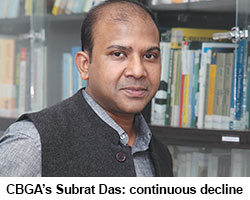 For next year (2020-21) the Centre’s allocation for education is Rs.99,312 crore, a modest 4.6 percent higher than the Rs.94,703 crore budgeted in 2019-20, and the actual, expenditure of Rs.94,854 crore (revised estimate) made for education in the previous year. Of this amount, Rs.59,845 crore is budgeted for school education and literacy and Rs.39,466 crore for higher education, plus a special allocation of Rs.3,000 crore for skills development. And although the entire army of budget commentators have not made the link, to this amount for education and skills, one should add the allocation of Rs.20,532 crore made towards ‘Anganwadi Services’ in 2020-21 (BE), which is an increase of nearly 16 percent over 2019-20 (RE), and 3.5 percent from 2019-20 (BE).
For next year (2020-21) the Centre’s allocation for education is Rs.99,312 crore, a modest 4.6 percent higher than the Rs.94,703 crore budgeted in 2019-20, and the actual, expenditure of Rs.94,854 crore (revised estimate) made for education in the previous year. Of this amount, Rs.59,845 crore is budgeted for school education and literacy and Rs.39,466 crore for higher education, plus a special allocation of Rs.3,000 crore for skills development. And although the entire army of budget commentators have not made the link, to this amount for education and skills, one should add the allocation of Rs.20,532 crore made towards ‘Anganwadi Services’ in 2020-21 (BE), which is an increase of nearly 16 percent over 2019-20 (RE), and 3.5 percent from 2019-20 (BE).
“Integrated Child Development Services (ICDS) renamed as Anganwadi Services two years ago, is part of the Umbrella ICDS Scheme implemented since December 2018. Other schemes under the umbrella are Scheme for Adolescent Girls (SAG), Pradhan Mantri Matru Vandana Yojana (PMMVY), Prime Minister’s Overarching Scheme for Holistic Nutrition (POSHAN Abhiyan), Child Protection Service and National Creche Scheme,” says CBGA’s analysis report.

Although this allocation for the country’s 1.3 million anganwadi centres which provide public ECCE (early childhood care and education) is grossly inadequate — the total population of children under-5 is 164 million — finance minister Sitharaman has implicitly acknowledged the importance of ECCE, to which the K. Kasturirangan Committee in its draft National Education Policy 2019 (currently receiving its final touches in the HRD ministry), has given high importance suggesting that it should be seamlessly extended to class II. This allocation of Rs.20,523 crore (allocated to the Union women & child development ministry) should in all fairness be added to the Centre’s 2020-21 education allocation, as should Rs.3,000 crore for skill development which would increase it to an unprecedented Rs.122,844 crore. However, even so the Centre’s outlay for public education next year would add up to a mere 0.54 percent of GDP, not nearly enough to make a significant impact.
“In order to reap the benefits of the demographic dividend and produce a skilled labour force, a substantial jump is needed in the budgetary allocation for the higher education sector. But the budget has proposed a meagre 3 percent increase in the higher education outlay over the previous year’s estimate,” laments CBGA’s Decoding the Priorities. “Though MHRD’s (ministry of HRD) budget has been increased in absolute terms, its share in total government expenditure has been continuously declining. A similar trend is observed when the education budget is compared with the country’s GDP. This reduced priority is also highlighted in the Economic Survey 2019-20, which shows that of the total public spending of 6.43 percent of GDP on social sectors (Centre and states combined), 3.1 percent of GDP is the spending towards education. This percentage is the same as what it was in 2010-11,” adds the CBGA report.
 Quite clearly, the vital importance of public education — the non-negotiable prerequisite of developing national human capital — has not dawned upon the BJP/NDA government, now in its second term of office at the Centre. Evidently, the entire political establishment seems to believe that education of the masses, i.e, public education, is a peripheral, low-priority issue. The unspoken consensus is that the poor in the bottom deciles of the country’s iniquitous social pyramid need only ritual education for form’s sake to continue to serve as gullible vote banks for avaricious politicians enamoured of the pomp and circumstance of office. Meanwhile the middle and upper classes avail privately provided pre-primary to Ph D education and continue to block upward social mobility.
Quite clearly, the vital importance of public education — the non-negotiable prerequisite of developing national human capital — has not dawned upon the BJP/NDA government, now in its second term of office at the Centre. Evidently, the entire political establishment seems to believe that education of the masses, i.e, public education, is a peripheral, low-priority issue. The unspoken consensus is that the poor in the bottom deciles of the country’s iniquitous social pyramid need only ritual education for form’s sake to continue to serve as gullible vote banks for avaricious politicians enamoured of the pomp and circumstance of office. Meanwhile the middle and upper classes avail privately provided pre-primary to Ph D education and continue to block upward social mobility.
Nor is the political class to be entirely blamed for the pathetic condition of Indian education across the spectrum. From the early 1970s when driven with socialist fervour, the late Congress prime minister Indira Gandhi packed the judiciary with ideologically “committed judges”, the Supreme Court of India has been passing judgements deploring the “commercialisation of (private) education”.
Even though in a belated landmark judgement in T.M.A. Pai vs. Union of India (2002), a full 11-judges bench by a 6-5 majority upheld the right of all citizens to engage in the “vocation” of education, and permitted private professional education (engineering, medical etc) institutions to determine their own admission processes and make reasonable profit for reinvestment in education, this judgement was substantially diluted by a smaller five-judge bench in the Islamic Academy Case (2003) which decreed the appointment of tuition fees adjudication committees chaired by retired high court judges in all states to entertain objections and determine if tuition fees levied are indeed reasonable. Unsurprisingly, private investment in private institutions of professional education has decelerated.
Moreover, obviously encouraged by judicial insistence on regulating tuition fees in private higher education, state governments across the country have introduced legislation to control and regulate the tuition fees of private schools to curry favour with the influential but somewhat confused middle class which aspires for first world K-12 education at third world prices. Currently, expensive lawyers of numerous representative associations of private schools are arguing writ petitions challenging unreasonably low fee ceilings imposed on private schools by several state governments.
The most draconian tuition fee ceilings have been imposed in the western seaboard state of Gujarat (pop.63 million) — prime minister Narendra Modi’s bailiwick — Rs.15,000 per annum for all primaries, Rs.25,000 for secondaries and Rs.27,000 for higher secondary private schools under the Gujarat Self-Financed Schools (Regulation of Fees) Act, 2017. Although the Act provides for appeal to four zonal fees regulation committees chaired by retired high or district court judges, these committees have little awareness of the requirements and compulsions of latter day K-12 education. On December 27, 2017 the Gujarat high court upheld the constitutional validity of the Act against which an appeal is pending in the Supreme Court.
Meanwhile, the issue of private school tuition fees which should be a bilateral contractual matter between school managements and parents — because the latter always have the option of enrolling their children elsewhere or in free-of-charge government schools — has become a major pain point for private school managements struggling to provide globally benchmarked K-12 education. The consequence of official harassment of private schools whose managements according to a prominent education consultant “have to spend more time in courtrooms than classrooms,” is that private investment — the country needs an estimated 200,000 new schools — has been reduced to a trickle.
In this connection, it’s also pertinent to note that because of official harassment, over 20,000 of the country’s estimated 400,000 budget private schools — low-fee private primary-secondaries for low-income households as an alternative to dysfunctional government schools — have been forcibly closed down for non-compliance with s.19 of the RTE Act, 2009. This section prescribes stringent infrastructure, teacher-pupil ratio and other norms for private schools, from which government schools are exempt.
In the circumstances, a bird’s-eye view of Indian education and human capital development in general presents a sorry mess, the outcome of chronic under-investment in public education and ham-fisted government interference with privately promoted institutions of education. To her credit, finance minister Sitharaman is aware of this phenomenon.
“The arithmetic of Union Budget 2020-21 clearly indicates that the government has no money to invest in education. The Rs.99,312-crore allocation for education is barely 5 percent over the revised estimate for 2019-20 and not enough to cover inflation. The government’s failure to meet the fiscal deficit target shows there was very little space for the finance minister to make the much-needed larger provision for education which is a modest 0.5 percent of  GDP. The only hope for across-the-board improvement of Indian education is the promise of permitting foreign investment in this sector. But this will require radical changes in India’s complex trusts and societies legislation which is unlikely to happen soon. Meanwhile domestic private investment in education should be encouraged for radical improvements in learning outcomes on scale. However, instead of encouraging private investment in K-12 education, state governments across the country are harassing private schools by imposing unrealistic tuition fee ceilings,” comments Atul Thakker, vice president, investment banking and head of education practice at the Mumbai-based Anand Rathi Financial Services Pvt. Ltd.
GDP. The only hope for across-the-board improvement of Indian education is the promise of permitting foreign investment in this sector. But this will require radical changes in India’s complex trusts and societies legislation which is unlikely to happen soon. Meanwhile domestic private investment in education should be encouraged for radical improvements in learning outcomes on scale. However, instead of encouraging private investment in K-12 education, state governments across the country are harassing private schools by imposing unrealistic tuition fee ceilings,” comments Atul Thakker, vice president, investment banking and head of education practice at the Mumbai-based Anand Rathi Financial Services Pvt. Ltd.
 This viewpoint is endorsed by Yatish Rajawat, until recently editor-in-chief of Daily News & Analysis (DNA) and newly appointed president of Centre for Civil Society (CCS, estb.1997), the well-known Delhi-based think tank. “Against the scenario of falling tax revenue because of the slowing economy, the finance minister has spread the available resources too thin across too many numerous sectors. Although lip service has been paid to the advantage of India hosting the world’s largest working age population by 2030, the provision of Rs.99,312 crore for education plus Rs.3,000 for skilling — barely 0.50 percent of GDP — is too meagre. There is little awareness in the minister’s budget speech and policy prescription that 100 million youth will be entering the workforce within the next decade,” says Rajawat.
This viewpoint is endorsed by Yatish Rajawat, until recently editor-in-chief of Daily News & Analysis (DNA) and newly appointed president of Centre for Civil Society (CCS, estb.1997), the well-known Delhi-based think tank. “Against the scenario of falling tax revenue because of the slowing economy, the finance minister has spread the available resources too thin across too many numerous sectors. Although lip service has been paid to the advantage of India hosting the world’s largest working age population by 2030, the provision of Rs.99,312 crore for education plus Rs.3,000 for skilling — barely 0.50 percent of GDP — is too meagre. There is little awareness in the minister’s budget speech and policy prescription that 100 million youth will be entering the workforce within the next decade,” says Rajawat.
Curiously, within the country’s academy and garrulous commentariat, there is no noteworthy criticism of the Central government’s runaway establishment expenditure. At Rs.6.09 lakh crore, establishment expenditure budgeted for 2020-21 is 11.5 percent higher than in 2019-20 and swallows almost 20 percent of the budgeted revenue of the Union government (Rs.30.95 lakh crore). Inevitably, the budget documents don’t provide details of the components that make up establishment expenses. Presumably they are wages, salaries, rents, travel and logistics and other revenue expenditure. That’s the huge bill of the 3.8 million Central government employees the nation is saddled with every year.
Yet there is a blanket of silence over the issue of establishment expenses in government, the academy and even media. While it’s difficult to suggest economies on particular items of establishment expenditure, there is a plethora of anecdotal evidence — the lavish perquisites of office of members of Parliament. Gleaming new SUVs, bungalows, dedicated airline, armed security, incessant foreign and domestic jaunts, motor car cavalcades, and an army of servants and chaprasis serve the country’s elected representatives.
Nor are politicians exceptions. The remuneration of Central government employees insulated against inflation by Pay Commission awards every ten years, is matched by generous perquisites of office including high quality residential and office accommodation and an array of medical, transport and pension benefits.
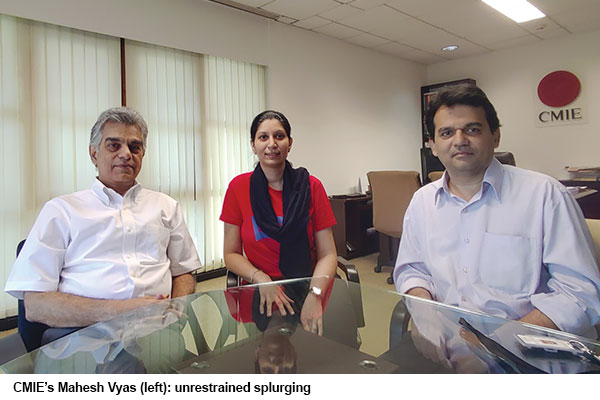 In private sector companies, the ratio of establishment expenses to total revenue averages 11 percent. In some public sector companies such as ONGC, the nationalised petroleum companies which have large revenues, the ratio is lower. Therefore there is no doubt that the Central government’s establishment expenditure at 20 percent of revenue is much too high and needs to be reduced to release resources for redeployment into public education, health and maintenance of law and order. There seems to be no restraint on ministers and bureaucrats splurging public money on themselves. The result is that government doesn’t have the resources to adequately fund the social sector and human capital development,” says Mahesh Vyas, managing director and chief executive of the Mumbai-based Centre for Monitoring Indian Economy Pvt. Ltd (CMIE, estb.1976), India’s largest business information company which recently generated a storm by revealing that unemployment in the Indian economy is at its highest in the past 40 years. According to CMIE data, the ratio of establishment expenditure to revenue in Reliance Industries Ltd — India’s largest private company (revenue: Rs.622,809 crore in 2019-20), is a mere 1.82 percent.
In private sector companies, the ratio of establishment expenses to total revenue averages 11 percent. In some public sector companies such as ONGC, the nationalised petroleum companies which have large revenues, the ratio is lower. Therefore there is no doubt that the Central government’s establishment expenditure at 20 percent of revenue is much too high and needs to be reduced to release resources for redeployment into public education, health and maintenance of law and order. There seems to be no restraint on ministers and bureaucrats splurging public money on themselves. The result is that government doesn’t have the resources to adequately fund the social sector and human capital development,” says Mahesh Vyas, managing director and chief executive of the Mumbai-based Centre for Monitoring Indian Economy Pvt. Ltd (CMIE, estb.1976), India’s largest business information company which recently generated a storm by revealing that unemployment in the Indian economy is at its highest in the past 40 years. According to CMIE data, the ratio of establishment expenditure to revenue in Reliance Industries Ltd — India’s largest private company (revenue: Rs.622,809 crore in 2019-20), is a mere 1.82 percent.
In addition to slashing establishment expenditure, there is scope for cutting annual defence allocations to release resources for human capital development. The outlay for defence is not disclosed in the summary ‘Budget at a Glance’ document of the finance ministry. In the expenditure budget it is declared as Rs.3.23 lakh crore, equivalent to 10.43 percent of the projected revenue and 1.43 percent of GDP.
Writing in the Business Standard (February 4) defence expert and analyst Ajai Shukla calculates the outlay on defence in 2020-21 at Rs.3.58 lakh crore and says that as a percentage of the total budget, defence expenditure despite it remaining “the government’s largest expenditure head” has declined from 17.4 percent in 2018-19 to 15.5 percent in 2020-21. Nevertheless, he writes that the “most striking figure” in Union Budget 2020 is that “unprecedentedly more money was allocated for army pensions (Rs.1.13 lakh crore) than for army salaries (Rs.1.11 lakh crore).”
Quite clearly there’s more to defence spending than is disclosed in the budget. One wonders under what head the huge amounts being spent on Rafale jets, Cobra combat helicopters, aircraft carriers and nuclear submarines whose purchase is the stuff of daily media headlines, are entered. Even if payments have to be made in instalments over decades, it’s self-evident that the Indian economy cannot afford defence expenditure on this scale.
Therefore for several years, your editors have somewhat solitarily argued that this country is paying too high a price for its 1.4 million defence personnel under permanent training. All three wings of the defence services — army, navy and air force — employ highly qualified engineers and technical personnel whose skill-sets are enhanced by excellent in-service training. In the circumstances the defence services are well equipped to earn part of their annual revenue expenditure by undertaking civil infrastructure and construction projects. The excellent infrastructure, including power stations, roads, buildings and well-laid out defence services cantonments are standing testimony to the revenue earning capabilities of the defence services.
In this connection it’s relevant to note that China’s People’s Liberation Army is one of that country’s largest industrial conglomerates and reportedly self-finances a substantial percentage of its annual revenue budget. “The PLA owns and operates a number of enterprises that are involved in food production, equipment repair, transport mining, services and provision of other day to day necessities of the military,” according to a research paper written by Thomas J. Pickford, a research scholar of the University of California, and briefly excerpted by US-based online publishers Taylor & Francis in 2016.

Self-evidently, another option to cut unproductive defence expenditure is for the country’s political leadership to evolve a national consensus to resolve long-standing boundary disputes with China and Pakistan and settle the status of Kashmir Valley, even at the cost of conceding independence of the Valley. India’s haphazardly demarcated border with China — reportedly the world’s longest pending boundary dispute — and the Kashmir imbroglio are major causes of the country’s massive annual defence expenditure, unsustainable for a country in which 48 percent of children under age five suffer chronic malnutrition. In this connection it’s pertinent to note the USSR (now Russia) — with which post-independence India shared close ties – expeditiously resolved its boundary issues with its former vassal republics after the fall of the Berlin Wall and the implosion of the Soviet Union in 1989. It’s a measure of the ineptitude of successive governments in New Delhi that they have failed to resolve India’s boundary issues in the north and north-east which are a huge drain on the economy, for over seven decades.
Slashing unproductive and wasteful government expenditure apart, there is also considerable room to enhance the revenue of the Central government to mobilise resources for investment in socio-economic and human capital development. The recent reduction in corporate taxes and higher threshold of Rs.5 lakh for individual incomes to become taxable were unwarranted. The primary causes of decelerating corporate and business investment in the Indian economy are inhospitable ground conditions — deteriorating law and order, unenforceable contracts, wobbly banking system etc — rather than high taxation.
Be that as it may, a paragraph in finance minister Sitharaman’s Union Budget 2020-21 presentation address which has aroused great interest within the beleaguered community of private education providers, is a proposal to permit foreign investment in education institutions. “It is felt that our education system needs greater inflow of finance to attract talented teachers, innovate and build better labs (sic). Therefore steps would be taken to enable sourcing ECB (external commercial borrowing) and FDI (foreign direct investment) so as to be able to deliver higher quality education,” said Sitharaman.
The excitement caused within the tribe of edupreneurs who are well-aware that 21st century India is the world’s largest market for preschool to Ph D education, but are confused by the stop-go signals being flashed by government, the judiciary and the establishment in general, is understandable. Interest rates charged by commercial banks abroad are a fraction of the extortionate rates levied by indigenous — including nationalised public sector — banks. Moreover foreign investors tend to be more patient than their Indian counterparts and their return on investment expectations are also modest by Indian standards.
 “There is widespread interest among foreign investors in Indian education because it’s common knowledge that this country has the world’s largest child and youth population. That’s why despite the high degree of policy uncertainty, reputable global investors including Nord Anglia, Cognita, Foundation Group, Morgan Stanley, Globeducate and KKR have already invested in India’s K-12 sector. There’s a huge demand-supply gap and India needs an additional 200,000 greenfield schools. But for serious FDI to flow into India, the law has to be changed to allow for-profit companies and firms to invest in education institutions. Currently, only charitable trusts and not-for-profit societies are permitted to promote education institutions. There is considerable policy uncertainty and lack of clarity on the issue of FDI in education, as well as on the issue of tuition fees regulation. One hopes that the finance minister’s remarks about encouraging ECB and FDI in Indian education are followed up by clear policies and guidelines to facilitate foreign investment in Indian education which is clearly in the national interest,” says Ankit Majmudar, an alum of the National Law School University of India, former counsel at Wadia Ghandy Solicitors, Bangalore and currently partner at Platinum Partners (estb.2008), a Mumbai-based law firm with 45 corporate clients countrywide.
“There is widespread interest among foreign investors in Indian education because it’s common knowledge that this country has the world’s largest child and youth population. That’s why despite the high degree of policy uncertainty, reputable global investors including Nord Anglia, Cognita, Foundation Group, Morgan Stanley, Globeducate and KKR have already invested in India’s K-12 sector. There’s a huge demand-supply gap and India needs an additional 200,000 greenfield schools. But for serious FDI to flow into India, the law has to be changed to allow for-profit companies and firms to invest in education institutions. Currently, only charitable trusts and not-for-profit societies are permitted to promote education institutions. There is considerable policy uncertainty and lack of clarity on the issue of FDI in education, as well as on the issue of tuition fees regulation. One hopes that the finance minister’s remarks about encouraging ECB and FDI in Indian education are followed up by clear policies and guidelines to facilitate foreign investment in Indian education which is clearly in the national interest,” says Ankit Majmudar, an alum of the National Law School University of India, former counsel at Wadia Ghandy Solicitors, Bangalore and currently partner at Platinum Partners (estb.2008), a Mumbai-based law firm with 45 corporate clients countrywide.
Debilitated by continuous under-funding of public education, ideological confusion, ill-conceived policies and clumsy interventions in privately provided education, 21st century India’s preschool to Ph D education system across the spectrum, is a mess which Union Budget 2020-21 has done little to clean up. This is a national tragedy in the making because human capital development is the only hope this resources-deficient country has to transform into an egalitarian and prosperous nation in the foreseeable future.
However, as repeatedly testified by the Annual Status of Education Reports of the Pratham Education Foundation, learning outcomes in primary/elementary education (classes I-VIII) are rock bottom. Moreover even carefully selected secondary students rank near last in international learning proficiency tests such as PISA, and not even one of India’s 993 universities — some of them over 150 years-old — is ranked among the world’s Top 200 in the widely respected World University Rankings of QS and Times Higher Education.
Quite clearly this situation is untenable. An estimated 10 million youth are streaming into the national jobs market every year with the overwhelming majority of them under-educated and ill-trained for productive employment in the organised sector of the economy. Radical decisions to slash establishment, subsidies and defence and other unproductive expenditure on the lines suggested above need to be taken to release resources for education and human capital development. Moreover, additional resources need to be raised through denationalisation of public sector enterprises and project-specific cess levies for investment in the social sector. Simultaneously, private providers of education need to be given all encouragement to supplement government initiatives in education.
Unfortunately, the prolix Union Budget 2020-21 presented to Parliament and the nation, seems oblivious that the era of business as usual has ended.
Budget 2020-21 reactions
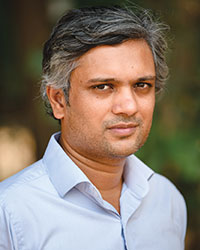 The pivotal initiative of this budget is the introduction of Ind-SAT, a general entrance and scholarship examination for international students seeking higher education opportunities in India. I think this move will put India on the global map for education — Rohan Parikh, Director, The Green Acres Academy, Mumbai.
The pivotal initiative of this budget is the introduction of Ind-SAT, a general entrance and scholarship examination for international students seeking higher education opportunities in India. I think this move will put India on the global map for education — Rohan Parikh, Director, The Green Acres Academy, Mumbai.
 Foreign collaborations in higher education — with or without FDI — offer a near term solution to the problem of quality human capital and employability, which can help us avert a demographic disaster and reap some dividend instead — Dr. Jitin Chadha, Founder-Director, Indian School of Business & Finance, New Delhi.
Foreign collaborations in higher education — with or without FDI — offer a near term solution to the problem of quality human capital and employability, which can help us avert a demographic disaster and reap some dividend instead — Dr. Jitin Chadha, Founder-Director, Indian School of Business & Finance, New Delhi.
The allocation of budget to BharatNet will have a deep impact on skilling rural India as it has the potential to open up online learning to students and professionals in remote villages — Vamsi Krishna, CEO & Co-founder, Vedantu, Bangalore.
 To ensure a reasonable return on the allocated Rs.99,300 crore to education sector, the government needs to put in place a policy framework, including notification of the National Education Policy, to address two important market failures: availability of high-quality teachers/ trainers and seamless industry-academia interaction. Regulation of education sector needs to give way to innovation to make it happen — Dr. Navneet Sharma, Dean, IFIM Business School, Bangalore.
To ensure a reasonable return on the allocated Rs.99,300 crore to education sector, the government needs to put in place a policy framework, including notification of the National Education Policy, to address two important market failures: availability of high-quality teachers/ trainers and seamless industry-academia interaction. Regulation of education sector needs to give way to innovation to make it happen — Dr. Navneet Sharma, Dean, IFIM Business School, Bangalore.
 For the government to achieve its vision of an India where all children get an excellent education, it will be crucial to incentivise states to improve learning outcomes of students and invest in leadership for education — Shaheen Mistri, Founder-CEO, Teach for India, Mumbai.
For the government to achieve its vision of an India where all children get an excellent education, it will be crucial to incentivise states to improve learning outcomes of students and invest in leadership for education — Shaheen Mistri, Founder-CEO, Teach for India, Mumbai.
The finance ministry’s focus on skill development will enable job creation which will compel more students to upskill. The proposed online education programme to provide quality education to students is a reformist step — Amit Gainda, Chief Executive Officer, Avanse Financial Services, Mumbai.
The proposal to encourage higher education in India through the ‘Study in India’ initiative is highly commendable. By introducing the INDSAT exam for Asian and African students, India can emerge as a destination for quality higher education — Dr. Ishari K Ganesh, Founder-Chairman of Vels University, Chennai.
 The finance minister has clearly highlighted that technology will drive the next wave of growth, with the provision of Rs.8,000 crore for the National Mission on Quantum Computing and Technology and announcement of two national-level science schemes. Moreover, the proposed fibre-home initiative will link 100,000 gram panchayats through BharatNet in 2021, ensuring Internet penetration in rural areas and expanding the ambit of online education in the country — Ramananda SG, Vice President (Sales and Marketing), Pearson India, Bangalore.
The finance minister has clearly highlighted that technology will drive the next wave of growth, with the provision of Rs.8,000 crore for the National Mission on Quantum Computing and Technology and announcement of two national-level science schemes. Moreover, the proposed fibre-home initiative will link 100,000 gram panchayats through BharatNet in 2021, ensuring Internet penetration in rural areas and expanding the ambit of online education in the country — Ramananda SG, Vice President (Sales and Marketing), Pearson India, Bangalore.
A forward looking budget that recognises the urgent need to bridge India’s skills gap by encouraging the education sector. Allowing foreign investment and external corporate borrowings by educational institutions will provide much needed new funding sources to facilitate their growth — Dr. Akhil Shahani, Managing Director, The Shahani Group, Mumbai.
 We, at the Manipal Group, are heartened by the government’s provision of Rs.3,000 crore for skill development. We believe it will bring focus on some new-age skills that will be invaluable in training the world’s largest working-age population. Another progressive proposal of Budget 2020-21 is to permit external commercial borrowing and FDI into the education sector to boost funding and infrastructure of educational institutions in the country — Subrat Mohanty, Group President, Manipal Education and Medical Group (MEMG).
We, at the Manipal Group, are heartened by the government’s provision of Rs.3,000 crore for skill development. We believe it will bring focus on some new-age skills that will be invaluable in training the world’s largest working-age population. Another progressive proposal of Budget 2020-21 is to permit external commercial borrowing and FDI into the education sector to boost funding and infrastructure of educational institutions in the country — Subrat Mohanty, Group President, Manipal Education and Medical Group (MEMG).
The budget has proposed significant changes which have the capability to revitalise the education sector. The proposed INDSAT exam could be the game-changer in terms of internationalising Indian education and the push for FDI in education will make India an international education hub — Niru Agarwal, trustee, Greenwood High International School, Bangalore.
 This year’s budget is quite aspirational. With Rs.99,300 crore allocated for education and Rs.3,000 crore towards skill development, there is great opportunity to add world-class technologies and facilities — Akshay Munjal, President, BML Munjal University, Gurgaon.
This year’s budget is quite aspirational. With Rs.99,300 crore allocated for education and Rs.3,000 crore towards skill development, there is great opportunity to add world-class technologies and facilities — Akshay Munjal, President, BML Munjal University, Gurgaon.
We applaud the Budget 2020-21’s focus on positioning India as a preferred destination for higher education for Asian and African countries by introducing scholarships through the INDSAT exam — Dr. Uday Salunkhe, Director, WeSchool, Mumbai.





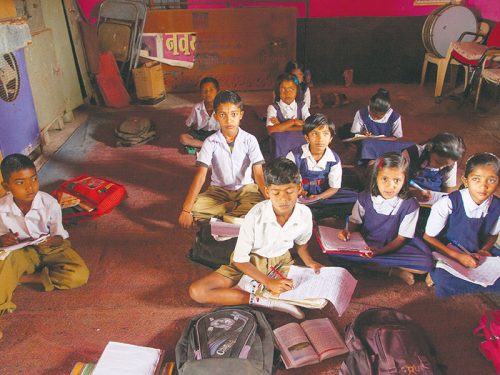










Add comment